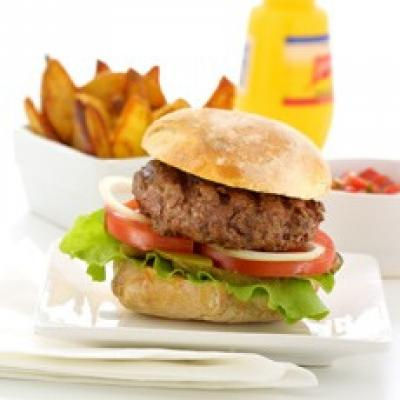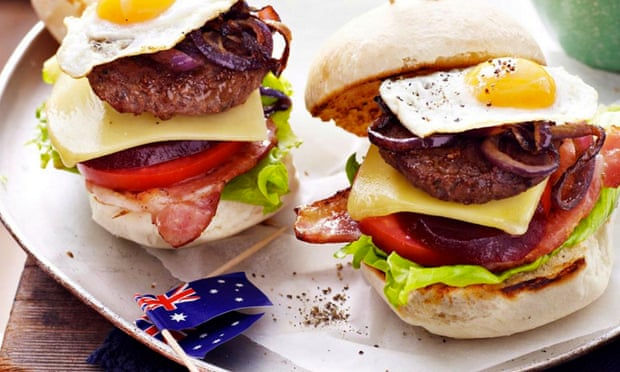Hamburgers
- rosemarydearman1
- Oct 18, 2019
- 7 min read
"If you're on a diet, don't eat a hamburger: it really is vital that it contains 20 per cent fat, as this is what keeps the meat moist while cooking." Delia Smith

Yes, we're having hamburgers for dinner tonight. And I am obviously not dieting. I know the inspiration came from the television, but I can't remember where. I just remember seeing a particularly tempting looking hamburger and thinking, yes I could do that. We are not having 'real' hamburgers though. They will be made with pork mince, and somehow or other I have to work in some of my leftover couscous salad although that might just end up as a side. I'm not sure yet. Anyway I'm looking forward to it. In fact it will be a typical 'modern' hamburger in that it won't be necessarily using any of the traditional things shown above. Might do a few oven chips though. The picture, by the way, is an illustration from an article on International Hamburger Day - yes there is one. It's May 28th for some reason.
"As ubiquitous as they are, hamburgers are a relatively recent addition to our diet. Claims as to the origins and inventor of the sandwich are many – among them, Genghis Khan and the German city of Hamburg, as well as Australia’s beloved rissoles – with the 1904 St Louis World’s Fair regarded by many (but not all) as its world premier." Max Veenhuyzen - The Guardian
Really you would have to say that Hamburg is the true originator though - although it seems they got the idea of the patty from Russia's steak tartare. And it was the Americans that added the bun. Wherever it came from originally it is very definitely now regarded as an American food. Indeed - the American dish and their gift to the world. McDonalds and Hungry Jack's (Burger King) rule the fast food world. So much so that The Economist devised the McDonald's Index to check whether the banks had got the currency exchange rates right. The index basically compares the cost of a Big Mac in two countries and then works out if the rate of currency exchange thus demonstrated equates to the official rate of exchange. Well that's what Wikipedia says anyway, although I actually thought it was something to do with showing how rich a country was - whether the poor could afford a Big Mac or not.
And this is what they get for their money from McDonald's and Hungry jack's. From left to right: A Big Mac ($6.45), a Whopper from Hungry Jack's ($6.20), a Hungry Jack's bacon burger ($7.00) All looking very tempting and, I have to say, all more expensive than I thought.
When the children were young, as a treat after a film we would go to Hungry Jack's for a burger. We favoured Hungry Jack's because they were a bit more flexible about what went into the burger. At McDonald's it came with what they thought you should have. No leaving out the mayonnaise or whatever it was you didn't want. But McDonald's and Hungry Jack's et al. is another topic altogether. Suffice to say that when I was touring around America with my friend Carole when we were both students, we ate a lot of hamburgers. They were cheap (we had virtually no money) and we considered that they contained most of the food elements that we needed to stay healthy. Well relatively healthy. We ate so many that I swore I would never eat another one again. But of course I have. Because they're pretty nice. If messy.
I occasionally make them at home. Which, of course, is the best way to do it. However I do cheat and make them with mince bought from the supermarket. A no no from all the chefs I checked out. You really should/must chop or mince your own meat - preferably chuck or something similarly fatty, because fat is what you need to make it moist. Delia says 20% fat, but I have seen as much as 40% mentioned. Delia is actually pretty practical about how to do it yourself:

"Cut the meat into chunks, put it into a food processor and blend until it looks like fine minced beef: however, don't overdo the processing, because if the meat becomes too fine, the burger will have a bouncy texture!"
But her version shown at left is a fairly uninteresting looking, if nutritious version.
Felicity Cloake runs through the basic things you might add, the bread you might use, etc., although I see that she recommends sourdough rolls as holding together rather better than a soft roll. And that's what we are having tonight. Some of Laurent's rustic sourdough rolls. I confess that I usually prefer those soft floury baps, but she is right about a soft roll collapsing under the weight of all that juice. The roll ends up really soggy and disintegrates in your hands. You need several paper napkins to hand in order to eat a hamburger. On the other hand another Guardian writer says:
"It’s all about structural integrity, both in the beef and the bread (say yes to soft white buns and no to chewy sourdough)." Max Veenhuyzen - The Guardian
And do you toast the buns or not?
Then there's the beetroot question.
What is the point of eating a hamburger in Australia if it doesn’t include beetroot, pineapple, bacon and egg?" The Guardian
This really is an Australian thing although nobody quite knows why. Apparently it was popular in the 30s and up until McDonalds and Hungry Jack's arrived here in 1971. They, of course, knew nothing of beetroot in hamburgers - or pineapple, and eggs and bacon either. But if you get your hamburgers in the small places that make them, then in Australia you will probably get beetroot. The English seem to like a pickle kind of taste as well. Several of them recommended gherkins or pickled onions.

This picture really does show though, how difficult it is to eat a hamburger. Which is why I never order one in a café. I am the world's messiest eater anyway and eating a hamburger is impossible. I mean you can't eat it with a knife and fork can you? So it's your hands or nothing. You really need a bib and, as I said, a pile of napkins. Australians love the indulgence though.
"But a burger patty of questionable origin, carelessly placed on top of some iceberg lettuce and a couple of slices of tomato, then topped with fried onion, a generous squeeze of BBQ sauce, beetroot, pineapple, bacon and egg in between a mass-produced sesame seed bun is a singular culinary delight. It is, quite simply, the very essence of Australian summer and no posh burger joint can ever hope to beat it." Gabrielle Jackson - The Guardian
Why do we love them so much?
"It's that primal, charred, slightly crunchy exterior, the soft, juiciness within - and of course, that perfect combination of toppings, chosen in childhood and sacred ever after."
says Felicity Cloake. And she may be right about the associations. Although I don't think we ever had them. I do remember Wimpy bars though - they were a kind of British hamburger - just the meat patty and fried onions - I do need fried onions in my burgers. That was the other thing I didn't like about American onions - they didn't cook them. They were just raw.
Hamburgers are even tempting to vegetarians and vegans.
"One of the first popular vegan-faux-meats? The Veggie Burger. Even vegetarians couldn't resist the taste of a tasty burger, they had to create an alternative just so they wouldn't have to leave all that was good and right about the world in the past." Only Melbourne
I even saw one writer confess that a sly taste of a friend's hamburger turned her from being vegetarian back to being a carnivore.
Which brings me to the other stimulus for this article - a section in the latest Coles Magazine on making hamburgers. It was actually a promotion for all sorts of Coles products - not the least of which were the prepared flavoured meat mince varieties they have recently introduced and also the non-meat mince varieties that are now on sale in the meat section. Not to mention the actual patties themselves. Plus the salads and the sauces, and the buns. No evidence of those charcoal buns though. I must check whether they have disappeared or not. They were really rather gruesome looking.
Here are their offerings - only one of which is a meat burger. From left to right, top to bottom - The mushroom burger - in which the meat is replaced by a mushroom, The Cheeseburger makeover which includes a fresh tomato salsa, a premade patty and the Australian beetroot. Then there is a Plant-based Vegan Burger - which doesn't even have a bun, replacing it with lettuce. The patty is some kind of synthetic beef, and finally the Vegetarian burger, which has a Coles curried vegetable patty. All of which goes to show that as long as you stick to the basic structure you can do just about anything. You can find the recipes in their latest magazine - from the supermarket, or online.

They also have a really weird suggestion of replacing the buns with a kind of bun made from fried noodles.
Like I said - anything goes really.
Now that summer is sort of approaching I guess the time of barbecues is also approaching and with barbecues come hamburgers. They're a good thing to serve up to a crowd because they can make their own individual hamburgers. You just have to supply all the ingredients. Then they put them together how they like. Nowadays those ingredients might be very varied and non traditional. And you can cover your vegetarian or vegan friends by supplying some kind of vegetarian patty. So not only are they tasty, creative and versatile, but they're playful too.
Burgers may be fast food, but they're also a craft." Felicity Cloake

Then there are sliders - which I have talked about before. They're just mini hamburgers really, and probably easier to eat for all that.
And a final small tip from Felicity Cloake who said that some Guinness added to the meat really improved the taste.
And another. When you shape the patties make an indent in the middle with your thumb before frying and then they won't pop up in the middle.
"an indulgence every human deserves to have once in their lifetime" Jamie Oliver
Only once?


























Comments